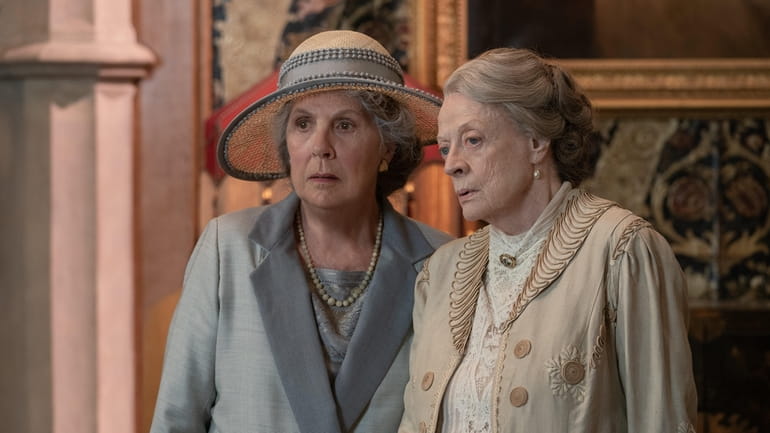'Downton Abbey: A New Era' review: Elegantly entertaining

Penelope Wilton stars as Isobel Merton and Maggie Smith as Violet Grantham in "Downton Abbey: A New Era."
Credit: Focus Features/Ben Blackall
PLOT An aristocratic family unexpectedly comes into possession of a French villa.
CAST Michelle Dockery, Laura Haddock, Hugh Bonneville
RATED PG (some adult themes)
LENGTH 2:05
WHERE Area theaters
BOTTOM LINE The hit British series returns to the big screen with another elegantly entertaining episode.
“Downton Abbey: A New Era,” the second feature film version of the long-running British television show, fully embraces our new era of content consumption, in which movies and series have become indistinguishable. If you missed the first film, released oh so long ago in 2019, don’t worry: Kevin Doyle, who plays the ever-gushing Mr. Molesley, will appear before the opening credits to recap the latest developments among the various lords, ladies, butlers and maids.
It's an appealingly old-fashioned (and quite helpful) device, and it suits this amusingly self-referential movie. Part of the story involves a film crew arriving at the grand estate of Downton Abbey to shoot a silent drama — the year is 1928 — which turns the house into a stage and inevitably requires some of our favorite characters to join the cast. If you thought “Downton Abbey” was an escapist diversion before, wait until you see the actors playing servants who serve as actors in a film within a film.
But that’s getting a little ahead of things. The central plot involves the Dowager Countess Violet Crawley (Maggie Smith, still the jewel in this series’ crown), who has unexpectedly inherited a French villa from a deceased former suitor. Her son, Lord Grantham (Hugh Bonneville), travels there to meet its rather miffed owners (Nathalie Baye and Jonathan Zaccaï), leaving Lady Mary (Michelle Dockery) to deal with film director Jack Barber (Hugh Dancy) and his two stars. One is Guy Dexter (Dominic West), a dashing gent with an Errol Flynn mustache. The other is Myrna Dalgleish (Laura Haddock), a glamorous diva with a gratingly low-class accent.
The real star of “Downton Abbey” is, as always, the swift and elegant writing of series creator Julian Fellowes. At the age of 72, he hasn’t lost his touch; if anything, he’s entering an almost Nietzschean phase of heightened clarity and precision. Many scenes in this movie consist of just three or four lines of quick, clever dialogue; they speed by in seconds. That helps director Simon Curtis (taking over from the previous film’s Michael Engler) pack half a dozen storylines into a two-hour movie quite neatly. Just about every “Downton Abbey” character gets a moment, though one of the longest — and surely most rewarding for fans — goes to Smith’s incorrigible Countess.
The perennial criticism of “Downton Abbey” — that it never digs too deeply into issues of wealth and class — remains valid, but that’s never where this franchise’s bread has been buttered. Each episode is a mini-vacation from reality, something many moviegoers surely need at the moment. As Mr. Molesley says, watching the film crew carry in the klieg lights: “For me, Hollywood is the ultimate dream factory. And I need dreams as much as the next man.”
Here's what other critics said about "Downton Abbey: A New Era"
Despite the promise of sweeping change in its title, "Downton Abbey: A New Era" is very much more of the same, which will be just fine with devotees of the long-running PBS hit. — THE HOLLYWOOD REPORTER
[Screenwriter Julian] Fellowes gives us an affectionate group hug, which is effectively what these encore visits amount to. — VARIETY
Fellowes’ dialogue may not be subtle, but the actors are so familiar and at home in these roles that they make up for whatever is lacking. — SAN FRANCISCO CHRONICLE
The film itself is the definition of a simple pleasure. — CHICAGO SUN-TIMES

